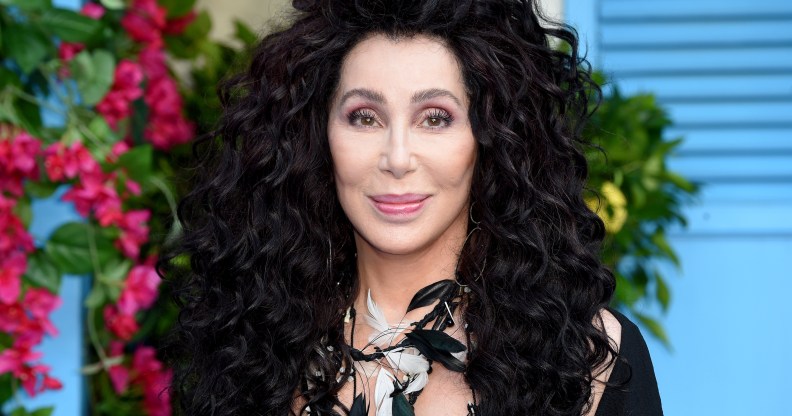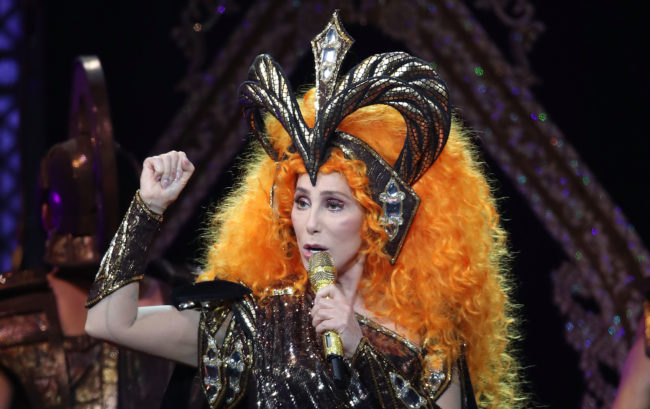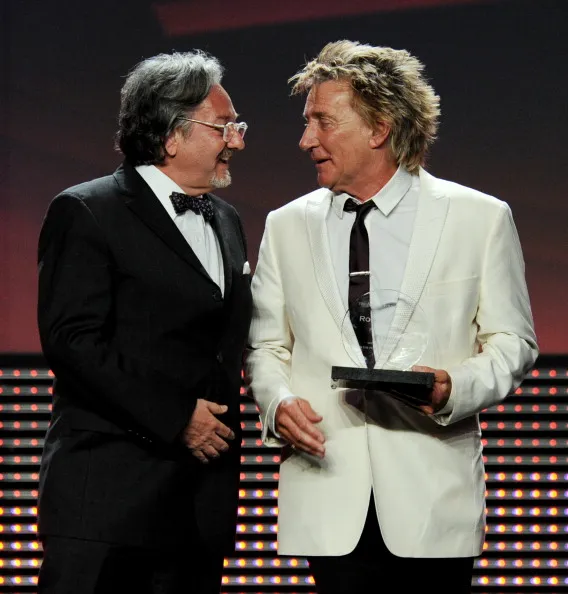Cher ‘Believe’ at 20: The story behind the world’s most enduring gay anthem

Cher announced the album in July (ANTHONY HARVEY/AFP/Getty)
When Cher released track “Believe” in 1998, she hit a new peak of commercial success. The song—famed for its pioneering use of Auto-Tune—arguably became the most enduring gay anthem on the planet. PinkNews takes a look at the background to the song and why, 20 years on, it still resonates with the LGBT+ community.
It was around autumn 1997, when Rob Dickins, the then chair of Warner Music Group UK, who signed Cher, first came up with the idea of the singer recording a dance album for her gay fans.
“I have a lot of gay friends, who adore Cher,” Dickins tells PinkNews. “Without really thinking, I said to her: ‘Gay men adore you, they don’t really like the records you’re making, but they love you. Now, wouldn’t it be a great idea to make a record, where they could love the record and love you?'”
At the time, Cher was experiencing a slight slump in her career, following the release of It’s a Man’s World (1995). The album had sold just 700,000 copies worldwide by 1997, and received poor reviews from critics (although, it has been praised in recent years).

It’s 20 years since Cher released “Believe.” (Scott Barbour/Getty)
And it was “Believe,” a rip-roaring club banger, which spearheaded Cher’s 22nd studio album of the same name. Literally, the song’s lyrics detail the empowerment that comes from learning to rely on yourself after a relationship breakdown. However, for gay fans, “Believe” took on a much different meaning.
“It’s in the spirit of [Gloria Gaynor’s] ‘I Will Survive.’ It’s a diva singing a song about, whatever happens, you’ve gotta believe there’s something else,” Dickins says of “Believe’s” lyrical content. “All of the gay anthems have something about them which is, it may not all be milk and honey, but you will break through.”
He continues: “It’s about strength and power and hope. And the fact that it’s not always easy to be who you are. Those songs echo with a lot of the gay community. I was just in Mykonos at a 40th birthday party, with about 30 gay men, and I was like a hero…I was suddenly the most popular man in the room.”
The story behind “Believe”
But, as Dickins explains, the story behind “Believe”—still the highest-selling single by a solo female artist in the UK—is complex and convoluted. In fact, the song, which has sold more than 11 million copies worldwide, nearly didn’t happen. Dickins was immediately met with resistance from Cher, who initially rejected all suggestions of making a dance album.
“Cher is tough to deal with,” says Dickins. “When she’s made up her mind, it’s hard to change it. And, so am I.” To convince her, Dickins set about putting together a “high-energy” dance track—”just one song,” he says—which would win Cher round and pave the way for the whole album.
He subsequently met up with songwriter and producer Brian Higgins, who had written tracks for Dannii Minogue among other stars, who sent Dickins 16 one-minute musical snippets of the choruses of 16 different tracks. It was the ninth chorus, he says, which struck him.

Cher’s Believe is known for being one of the first songs to use Auto-Tune. (Ethan Hein/Flickr)
“I love this, I really love this,” Dickins remembers thinking at the time. He says it was this sample that ended up as the chorus on Believe “exactly how you know it.” The producer asked Higgins to write the rest of the track, but was disappointed by what the writer came up with.
“It was awful,”explains Dickins. “There was this fantastic chorus. Then an awful verse, an awful bridge, and an awful middle-eight.” According to Dickins, a “Frankenstein song” was then pieced together using different writers, most of whom were recruited by producer Brian Rawling, until he was finally pleased with the final product.
In total, “Believe” credits six songwriters: Brian Higgins, Stuart McLennen, Paul Barry, Steven Torch, Matthew Gray, and Timothy Powell. Cher herself has even claimed that she contributed to the songwriting process, too.
For Dickins, he had to get the song right if he wanted to get Cher to sing it—and his efforts paid off.
Dickins says, when he emailed the demo of the track to Cher, she phoned him straight away, telling him: “I love it.” He adds: “As strong and tough as she is, she is a realist, she knows when something’s right.”
With Cher on board, the vocals for the song, which went on to win a Grammy for best dance recording, were soon recorded in a studio in west London. Dickins says that it was Cher, inspired by watching a musician using a vocoder (a voice distortion technology) on a television show one morning, who asked for the same effect to be used on her song.
Because the studio did not have a vocoder, Mark Taylor, a producer on the song, instead used Auto-Tune—a new audio processor released in Spring 1997—on Cher’s vocals. Rawling says that the impact of Cher’s distinctive Auto-Tuned singing was ground-breaking—and key to the track’s success.

Rob Dickins (left) and Rod Stewart in April 2011 in Los Angeles, California. (Kevin Winter/Getty)
“The genius of it was due to Mark Taylor finding a place to use the Auto-Tune effect, which turned this good song into a worldwide, number one song,” Rawling says. “The song, the production, the Auto-Tune, and the iconic artist Cher—those ingredients all worked together. If it was any other artist it wouldn’t have been the same.” Dickins, too, believes that the use of Auto-Tune is “one of the reasons it’s so big.”
Gay anthem
Rawling also owes much of the success of “Believe” to Cher’s strong gay following. “I think the gay audience is the most loyal, and Cher as an artist is iconic to them,” he says. “I think this record magnified that as it’s a powerful uplifting song—[it was] a song and a record they wanted from her.”
Dickins, too, says the song quickly struck a chord with the gay community. He recalls a gay friend phoning him after “Believe” was released, who had been in London gay club Heaven when the song was played. Dickins says his mate told him: “It like a magnet, everyone was on the dance floor. If you want to make a record for us, you’ve succeeded.”
For Dickins, the enduring impact of “Believe” is the result of multiple factors, all coming together at the right time and creating something amazing. “It was the combination of everything,” he adds. “Cher, the beats, the melody, the chorus, the Auto-Tune. All the planets lined up, and it just exploded.”

